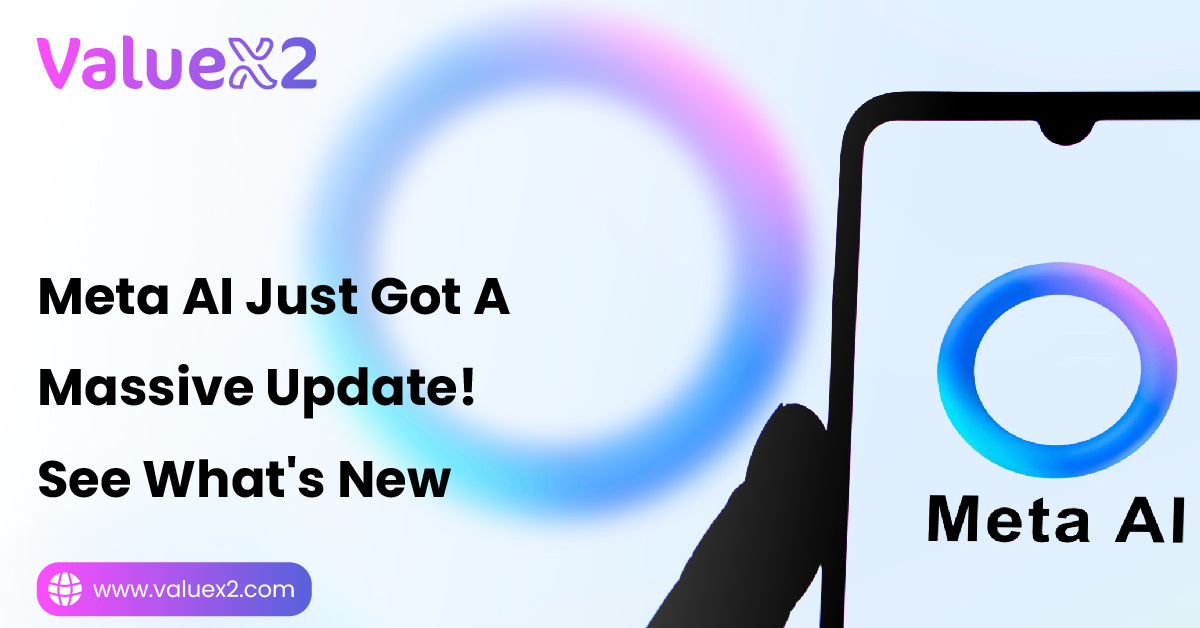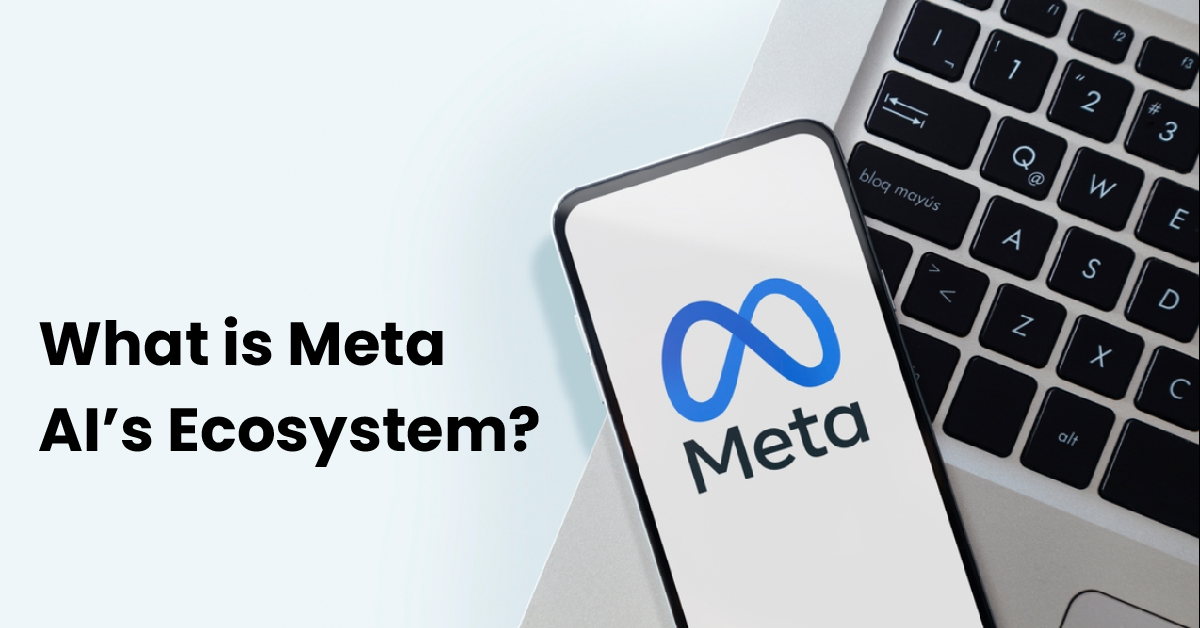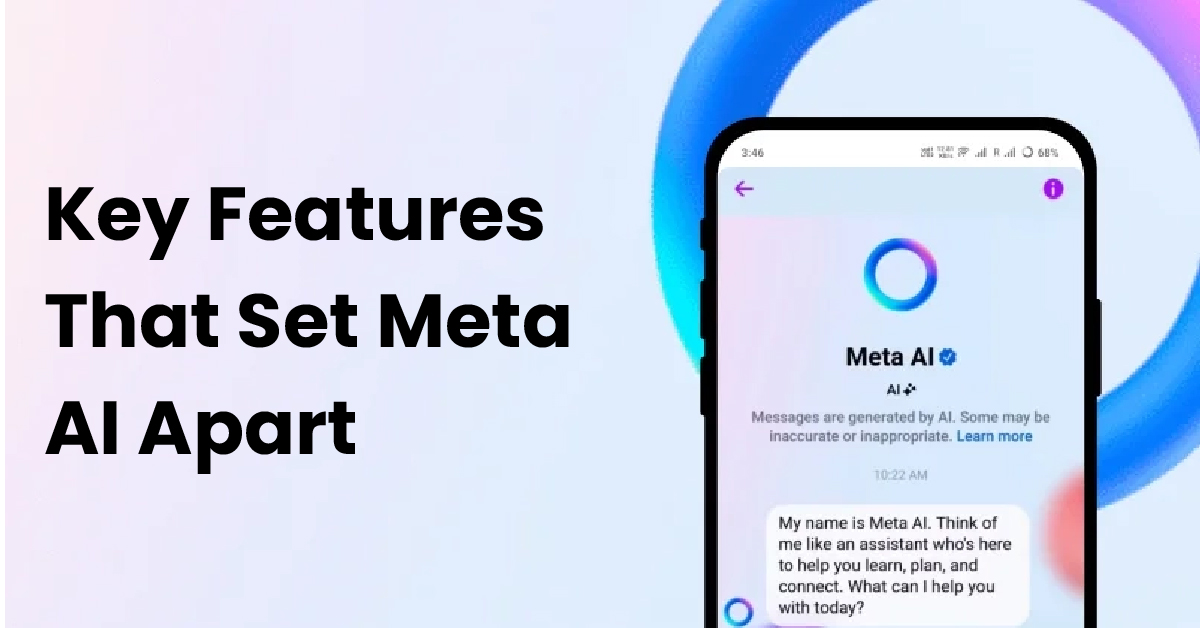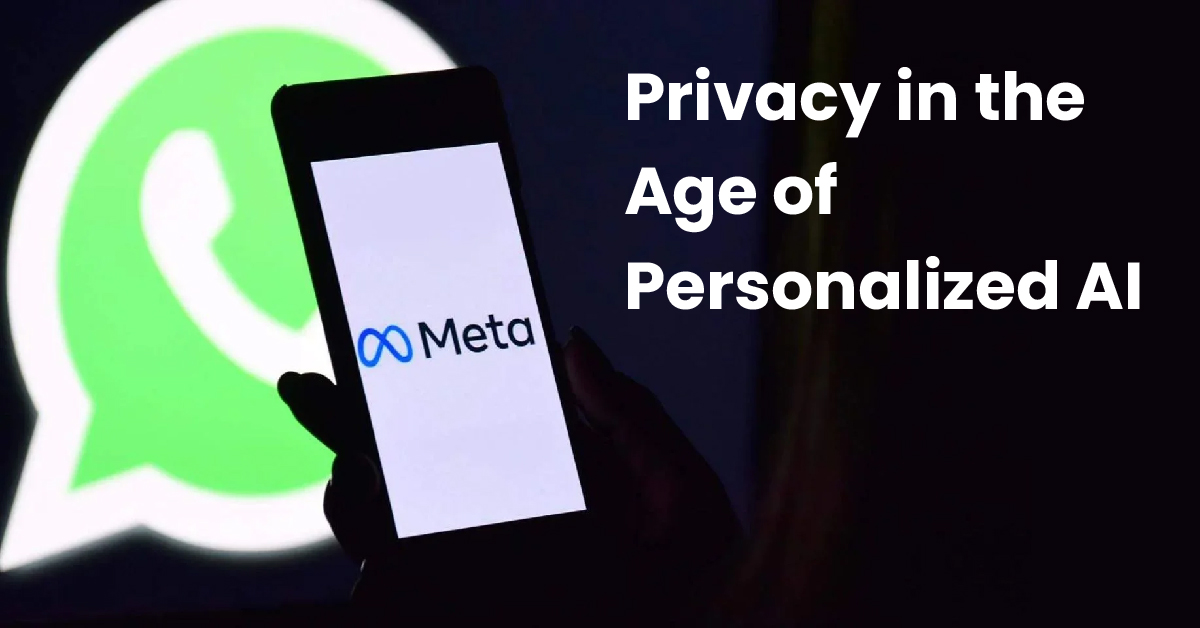Meta AI launches an app for 1 Billion+ potential users overnight, and Meta can give a huge thanks to its Facebook, Insta & WhatsApp reach. This blog will show how it stacks up against Giants and how a working professional can benefit from this new App.
 We all have a good idea of how fast the AI industry is going. Every tech giant is trying to take the next step and trying to bring something new to the table. We won’t be surprised if there is something better than this model tomorrow.
We all have a good idea of how fast the AI industry is going. Every tech giant is trying to take the next step and trying to bring something new to the table. We won’t be surprised if there is something better than this model tomorrow.
Let’s not waste time and break the big news to you. Meta, which includes Facebook, Instagram, and WhatsApp, made a significant announcement. Meta launched its standalone Meta AI app on April 29, 2025, at its first LlamaCon developer conference. Before discussing this app, we will discuss how it is different and, yes, a game-changer regarding productivity.
This move that Meta made shows that Meta wants to have its own unique space in the world of AI. One of the reasons why many users like Meta is that they are committed to providing a highly personal experience. Meta was previously connected to all of the social media.
Now, with the App, they wish for its AI to be an ultimate assistant; the funny part is they already have a billion people base, and now they can expand after this move. Let’s explore what Meta AI has to offer, how it works, how it stacks up, and why flexibility is the name of the game now.
What is Meta AI’s Ecosystem?
 First, let’s talk about what the Meta AI app is. It’s a standalone app, free on Android, iPhones, and iPads. It provides users with a place to engage with Meta’s AI assistant. That’s different from when it was last integrated into Meta’s other apps. But calling it “standalone” doesn’t do it justice. The App is a rebranded and highly improved version of the “Meta View” app. People used the App primarily for Meta’s Ray-Ban smart glasses.
First, let’s talk about what the Meta AI app is. It’s a standalone app, free on Android, iPhones, and iPads. It provides users with a place to engage with Meta’s AI assistant. That’s different from when it was last integrated into Meta’s other apps. But calling it “standalone” doesn’t do it justice. The App is a rebranded and highly improved version of the “Meta View” app. People used the App primarily for Meta’s Ray-Ban smart glasses.
This move tells us about Meta’s strategy. By incorporating the glasses App into the fundamental AI interface, Meta is attempting to make its AI experiences more inclusive and high-end on all its platforms. The goal is to make Meta AI ubiquitous and everywhere. You can find it while swiping on Instagram, messaging on WhatsApp, browsing Facebook, Messenger, or even with your Ray-Ban Meta glasses. For current Meta View users, the process should be easy. Their paired devices, preferences, and content will automatically migrate to the new Meta AI app.
This close integration overflows into its operation, too. You can start an AI chat using a voice command with your glasses and resume it later within the App or on the web at meta.ai. This convergence of services signals Meta’s ambitious vision: to build an AI layer that brings its software and hardware together. This could make the assistant a gateway to enjoying Meta’s world and render the return journeys more probable.
You may also find this article interesting: Grok AI: Is Elon Musk’s AI Chatbot the Real Deal?
How Good Is Llama 4?
 The force behind this personal experience is Meta’s latest large language model (LLM), Llama 4. Before this, they used Llama 3.3 with 70 B parameters as their strongest model. LLMs can be tricky at times, but Llama 4 is said to be enabling a couple of significant things in the App:
The force behind this personal experience is Meta’s latest large language model (LLM), Llama 4. Before this, they used Llama 3.3 with 70 B parameters as their strongest model. LLMs can be tricky at times, but Llama 4 is said to be enabling a couple of significant things in the App:
Better Conversations: Llama 4 tries to generate responses that sound more natural, personal, and to the point than before.
Improved Thinking: The following model improves at thinking out of trouble and being directed. This can make the AI more helpful and manageable. But, like most AIs today, sometimes it gets incorrect or “hallucinates,” i.e., gives erroneous information. For most working professionals, it’s recommended to have AI assistant apps on their phones so that if one makes a mistake, they can look for better results somewhere else.
Voice Interaction: It powers the advanced voice capabilities, working towards smoother, more fluid conversation.
Deep Personalization: The model’s capabilities are first when considering user information and asking for the correct answers.
Llama 4 forms a large extended family of models for Meta. They include their versions, like low-power “Scout” and more powerful versions like “Maverick.” They employ high-end techniques like Mixture-of-Experts (MoE) design and support diverse input (e.g., text and pictures). This is the quick succession of Llama 3, Meta’s model that came earlier. This illustrates Meta’s vast investment and focus on improving AI technology, which is mainly distributed for free.
It’s reassuring to hear that AI performance is so competitive when compared. There has been some discussion about how well Llama 4 versions work, particularly in benchmarking tests. Although Llama 4 is indeed powerful, the particular version within the free App may differ from special models designed for benchmarking. This is to say, although users get the benefits of Llama 4’s advances, their experience may not necessarily meet the best performance figures that appear in technical comparison.
You May also find this article interesting: ChatGPT vs. DeepSeek: Which AI Model is Better?
Key Features That Set Meta AI Apart
 Meta AI isn’t just trying to copy existing chatbots. It’s adding features that use Meta’s special strengths in social networks and user data.
Meta AI isn’t just trying to copy existing chatbots. It’s adding features that use Meta’s special strengths in social networks and user data.
Hyper-Personalization: Your Social Graph as AI Fuel
The most significant distinction is Meta AI’s intensive personalization. Connecting your Facebook and/or Instagram accounts (via Meta’s Accounts Center) allows the AI to access a great deal of information. That includes your profile data, what you engage with and like on posts, and maybe data from past conversations within Meta’s apps. The App also has a “Memory” feature. This enables it to recall some things you tell it or learn from chat, like where you’d like to go on vacation or the birthdays of loved ones. This makes further chat more applicable.
The idea is an AI helper that truly “gets to know you.” It can provide more helpful tips and contextually appropriate answers. For instance, consider requesting ideas for a holiday, and the AI already has knowledge that you like beaches and low-cost airlines due to your previous activity. Based on years of social media use, this kind of personalization is hard for competitors to match if they don’t have access to that big social network. This sophisticated feature of personalization is starting in the US and Canada.
However, this potential already raises privacy issues. Specific customers and critics are concerned about their vast social media history being utilized to train or direct an AI. They describe it as possibly “intrusive” or as their previous digital life being “turned against them” lightly. Meta’s unique advantage – access to unprecedented user information – can thus be a two-edged sword. Its success will likely hinge on showing value that tips the balance beyond these privacy concerns and offering users transparent, straightforward ways to control their data.
The Discover Feed: Building AI Social
Another unique section is the “Discover” feed. It is a one-of-a-kind section of the App and is on the web. In this section, users can choose to share their chats with Meta AI – insightful questions they typed and the text, picture, or graphics they received as a reply.
Interestingly, sharing is not mandatory. By default, your conversation is kept confidential. But if shared, fellow members can browse through the feed, like, comment, share, and even “remix” prompts they like. Remixing is about copying the prompt to try it themselves.
Meta calls this how to build a community for collaborating with AI. It enables users to motivate each other, learn new ways of framing questions, and see all the different things the AI can do. Meta worked with various content creators to seed the feed. This social feature differs significantly from the individual experience of talking to chatbots like ChatGPT.
Trying to graft the social network sparkle of Meta onto AI interaction is an interesting experiment. It could make finding good prompts simpler for everyone and create powerful network effects, enabling users to tap the full potential of the AI sooner. But it could also turn AI into something that one does to brag or yet another endless feed of low-quality material, as some initial reviews suggest.
Talk Naturally: Advanced Voice & Full-Duplex
Meta relies heavily on voice as a primary method of communication with its AI. The App can be easily activated by voice when undertaking other tasks. A symbol clearly shows that the microphone is turned on. Llama 4 is also credited with refining the voice models to offer more conversational and personal responses.
The most widely discussed voice feature is an experimental demo of “full-duplex speech technology.” Simply put, full-duplex allows two-way communication at the same time. It’s like a natural phone call where both parties can talk and be heard simultaneously, even interrupting each other. This differs from half-duplex systems, like walkie-talkies, where one person can speak at a time.
Meta’s update yields a more human-sounding delivery. The AI develops voice responses from the conversation, with natural pauses and filler words (“umm”), instead of reading from text aloud. Initial tests characterize this as being “smoother” sounding and more fluid than the voice conversation of ChatGPT, which is turn-based.
Nevertheless, Meta states that this is presently a demo. Testers of the application may have problems or technical issues. In addition, the demo version does not capture real-time web data and might give less accurate responses than the standard AI voice mode. This new voice feature and demo were first released in the US, Canada, Australia, and New Zealand.
While experimental, the focus on full-duplex means Meta heavily invests in enhanced voice conversation as a key point of emphasis for next-generation AI assistants. It aims to move beyond the often clumsy turn-taking of present systems.
Create and Edit: Integrated Image Generation & More
Meta AI is not just about chat. The App naturally includes the “Imagine” feature. This lets you generate and even edit images with a text or voice prompt directly within the chat. The image generator is described as fast and showing previews while you input your prompt. While generally considered fun and speedy, some reviews remark that the image quality, especially for realistic photos, can sometimes expose obvious AI mistakes.
Aside from the mobile App, the Meta AI website (meta.ai) has undergone significant overhauls. It’s designed to be friendly for large screens and desktops. It includes voice interactions, the Discover feed, and a better image-making experience with more presets and controls to adjust style, mood, and lighting.
Also, Meta is testing out potentially helpful productivity features in some places. These include a rich document editor to write documents with text and pictures (exportable as PDFs) and importing existing documents so the AI can read and understand them.
These abilities demonstrate that Meta’s plan for its AI is something more than a simple chatbot. It’s turning Meta AI into a tool for productivity and creativity, blending these capabilities into the stream of conversation. That could turn it into a hub platform for several digital activities.
Meta AI vs. The Titans: How Does It Stack Up
Meta AI enters an already crowded arena with big-ticket names like OpenAI’s ChatGPT, Google’s Gemini, Anthropic’s Claude, and others, including xAI’s Grok. Meta AI participates in the general functionalities of competition – responding to questions, generating images and text, summarizing articles, and web searches. The difference, presumably, is already apparent to all.
To get a better idea, we created this table to understand how these 3 Giants perform.
Table 1: Meta AI vs. Key Competitors – A Snapshot
| Feature/Aspect | Meta AI | ChatGPT | Gemini |
| Core Model | Llama 4 (MoE, Multimodal focus) | GPT-4 series | Gemini series |
| Personalization | Deep (FB/IG data + Direct Input + Memory) | Moderate (Direct Input + Memory) | Moderate (Google Account data + Direct Input) |
| Social Interaction | High (Discover Feed for sharing/remixing) | Low (Link sharing, Custom GPTs) | Low |
| Voice Interaction | Fluid (Full-Duplex Demo) | Turn-based | Integrated (Google Assistant context) |
| Ecosystem Int. | Very High (Meta Apps, Ray-Ban) | Moderate (API, Plugins) | High (Google Workspace, Android) |
| Pricing | Free | Free & Paid Tiers | Free & Paid Tiers |
| Unique Feature | Discover Feed | Custom GPTs | Deep Google integration |
You may also find this article interesting: Mistral AI: The Fastest Growing Open-Source AI Tool
Early Reviews & User Experience: Hits and Misses
As with most major tech launches, early reactions to the Meta AI app have been mixed. Both users and critics have pointed to positives and issues that are easy to see:
The “Hits” (Adequate Aspects):
- Ease of use: Being part of widely used apps makes it easy to use, while the dedicated App offers a separate environment.
- Personalization Possibility: Tailing responses to social data is fascinating and potentially very valuable to some.
- Discover Feed: The social feed is considered unique and different, giving another application of AI.
- Image Generation: The “Imagine” feature is generally described as a cool, fast, and fun tool, especially its live preview.
- Voice Interaction: The voice focus, like being smoother than others, gets positive comments.
- Good at Specific Tasks: It compares products for shopping or recipes and summarizes web articles.
“The Misses” (Criticisms & Weaknesses):
- Accuracy & Errors: A chief concern is the AI’s tendency to make up (\”hallucinate\”) or give wrong answers. This was especially seen in research queries and trip planning, with some calling its travel suggestions a “disaster.” Some reviewers rate it as less accurate than the market leaders.
- Needs Better Prompts: Users often must request follow-up questions or reword their prompts to get the desired outcomes.
- Unpredictable Performance: The way it performs is very task-dependent, making the experience unpredictable.
- Image Quality: As fast as they are, produced images, especially realistic ones, are apt to display apparent AI-related artifacts.
- Privacy & Intrusiveness: The strong personalization based on social media data creates discomfort in some users. The incorporation itself feels like an unwelcome imposition for users who did not invite an AI assistant into their social streams.
- Discover Feed Problems: The feed can be cluttered or just another source of distraction.
- Restricted Rollout: Key capabilities like deep personalization and voice AI are present in select places. This limits the experience for the majority of users globally. The full-duplex voice is only limited to a demo as well.
Privacy in the Age of Personalized AI
 Sharing Facebook and Instagram personal data to power Meta AI’s personalization is undoubtedly the most significant privacy issue. Meta says that this data, at times encompassing profile data, likes, interactions, location, age, gender, and interests it gathers via activity on its platforms, is used to make the AI more useful and pertinent. It may also be utilized to make its AI models overall. The firm cites its long history of tailoring user experiences on its sites.
Sharing Facebook and Instagram personal data to power Meta AI’s personalization is undoubtedly the most significant privacy issue. Meta says that this data, at times encompassing profile data, likes, interactions, location, age, gender, and interests it gathers via activity on its platforms, is used to make the AI more useful and pertinent. It may also be utilized to make its AI models overall. The firm cites its long history of tailoring user experiences on its sites.
So, what is in the users’ control? The picture is somewhat complicated, with settings scattered in various locations:
Meta Accounts Center: This is the central place to manage linked Facebook, Instagram, and other Meta accounts. Many privacy settings, like ad preferences and activity on Meta’s platforms, are managed here. They apply consistently across linked accounts. Connecting or disconnecting accounts here directly affects the data available for personalization.
Meta AI App Settings: Users can check “Data & privacy” settings inside the App. This contains options for controlling whether the App’s prompts are suggested to the user on Facebook or Instagram.
Managing Your Information: Users can generally locate, download, or delete information via a series of settings menus. Voice recordings Meta AI has stored can be deleted via the app settings, although there is no longer a choice to stop storage altogether.
Choosing Out of Training AI Data: This is likely the toughest section. People can make requests using forms like the “Right to object” or the “Data Subject Rights for Third Party Information Used for AI at Meta” form found in Help Centers. This process tries to stop future use of personal data to train Meta’s AI systems. However, it requires providing specific information. It does not guarantee the deletion of information from third-party sources or posts made by others that cite or depict the user. And there is no opt-out option for the use of WhatsApp data. Meta suspended the use of EU user data for training just recently.
Limiting Interaction: Individuals may mute AI chat or not use AI features. But this doesn’t stop the underlying data harvesting if accounts remain linked.
Conclusion: Is the future personal, social, and agile?
Meta’s standalone AI app is a giant and bold step in the evolution of digital assistants. Meta is moving in the right direction by combining its Llama 4 model, its deep personalization based on its social network data, a unique social discovery function, and a focus on natural voice interaction. It’s a bet that the future of AI support isn’t just in brute smarts but in context, customization, and social connection.
In a world permanently changed by new things like Meta AI, staying ahead involves adopting new working methods. ValueX2 is your partner of choice to navigate this digital change. We help people and organizations build the capabilities to succeed. We excel at evangelizing Lean-Agile practices and Scrum methodologies. We empower you with the mindset and ability to deliver value effectively in fast-changing environments.
Why are Agile and Scrum so important today?
They provide the frameworks to do the following things:
- Respond quickly and well to changing market trends and technology shifts.
- Deliver value to customers sooner and more regularly.
- Improve collaboration and increase team productivity.
- Increase customer and employee satisfaction.
See our courses to reserve a session at a convenient time and begin your journey to unlock your potential in this exciting new era. Time changes fast, and every professional must learn to keep up with the latest.
Meta AI FAQ
Below are some frequently asked questions about the new Meta AI app:
What is the Meta AI app?
It’s a free, independent mobile app (iOS/Android) and site (meta.ai) that provides access to Meta’s personal AI assistant, Llama 4-based. It’s deeply integrated with Facebook, Instagram, WhatsApp, Messenger, and Ray-Ban Meta glasses.
How is Meta AI different from ChatGPT?
Significant differences include its deep personalization from linked Facebook/Instagram data, a dedicated “Discover” feed for social sharing and remixing of AI prompts, strong cross-app and device integration across Meta’s services, and a strong focus on natural voice interaction (including an experimental “full-duplex” mode). Early testers say it may be less accurate than ChatGPT in some ways and occasionally make errors.
What is Llama 4?
Llama 4 is Meta’s newest set of large language models. It’s the artificial intelligence engine powering the advanced features of the Meta AI app, including more natural chat, personalization, voice functionality, and in-app image creation.
How is personalization achieved? Is it private?
It draws on information from connected Facebook and Instagram accounts (profile information, likes, interactions) and recalls things said in conversations to personalize responses. This concerns some users with privacy. Meta offers controls via Accounts Center and app settings, and sharing with the Discover feed is optional (you must opt-in to do so). Conversations are private by default.
What is the Discover feed?
It’s a social feature in the App where users can share their AI prompts and output (text, images). Others can see, engage with, and “remix” these shared exchanges, facilitating the community to learn together.
What is a “full-duplex” voice?
It’s a voice technology experiment shown in the App. It supports two-way, concurrent conversation, like a natural phone call, where you can shut down the AI. Typical chatbots often use half-duplex (turn-based) conversation. The demo version is limited; for example, it does not show real-time data.
Is the Meta AI App free?
Yes, the Meta AI app and its key features are currently free to access.
Does it replace the Meta View app on Ray-Ban glasses?
Yes, the Meta AI app consolidates and replaces the Meta View app. It’s the new flagship companion app for managing Ray-Ban Meta smart glasses.

Bhavna is an Agile Coach and Consultant with 15+ years of experience in advisory, corporate finance, IT assurance, and operations at Big 4 and within the industry in the UK and India. She has recently been the CEO of a start-up where she implemented agile practices within HR, Marketing, and Product teams.
She is also a SAFe® Practice Consultant (SPC) and authorized instructor for ICAgile Agility in HR (ICP-AHR), Agility in Marketing (ICP-MKG), and Business Agility Foundations (ICP – BAF) training courses. She provides training for agile transformation to corporate, public, and private batches, as well as consulting for enterprise agile transformation.






